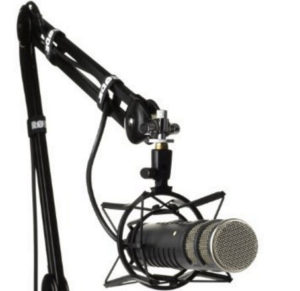
A few weeks ago I returned to Dragon NaturallySpeaking—reassured by several books that I could boost the accuracy of my speech recognition if I truly tried. I’d used Dragon before when my arm hurt. Dragon scrambled just too much.
Well, yes, with the new tricks in use, Dragon has been worth the trouble even though I’m no slowpoke as a typist.
From the earlier post, you already know that Dragon demands a good microphone, in my case a USB incarnation of the Blue Yeti. But something else counts, too—having the microphone as close as possible to your lips.
That way, you can keep sensitivity down enough to reduce the distractions from background noise. And even without that factor, accuracy seems to be better.
You can search Amazon for microphone boom arms at varying prices, but in my case, I needed the RODE PSA1 Swivel Mount Studio Microphone Boom Arm. The current price of $99 on Amazon Prime seems outrageously high since the Yeti itself sells for $113. But that’s what my home office requires.
Long-time followers of the TeleRead may recall that I write in a recliner several feet away from my monitor. I wanted an arm that could stretch from the table holding the monitor to within an inch of my mouth when I sat in the chair. The Rode boom arm did the trick. It not only was long enough, it was also sturdy enough to hold a microphone weighing several pounds.
I didn’t even need to buy an adapter to attach the Yeti to the boom arm—one came with the arm.
What I’m using dictation for
Not every piece of writing lends itself to dictation. If I’m working on something requiring an extremely precise choice of words, I’ll stick to my keyboard. And if I want to link constantly as I go along, somehow things seem to go faster with regular typing than with dictation. You may disagree. I’ve been dictating the current blog post, both in Open Live Writer where it started out and in the Web editor of WordPress.com.
Especially, dictation shines when you’re writing off the top of your head and have a lot to say at once. I used Dragon NaturallySpeaking to crank out an 11,000-word policy statement for the TeleRead-LibraryCity campaign for a national digital library endowment (shorter document here). I suspect that voice recognition probably saved me at least a day or two. A friend just broke her wrist, and I can confidently recommend Dragon.
If you’re an older writer and you suffer from a past or present repetitive stress injury, Dragon might do exactly what its boosters say—and prolong your working life.
Which version to get
Even with the older versions of Dragon, you may find a noticeable improvement over the dictation systems that may be built into your operating system. Dragon NaturallySpeaking Premium 13.0 could be at least adequate for your purposes—the disk version sells for $90 at Amazon. And for now, at least, I’m seeing an open box version for $60.
I myself have just installed Dragon Professional Individual 15.0. It now sells for $200 as an upgrade and $300 from scratch, but was available to me for $99 through an upgrade offer. The latest version may have improved accuracy a tad, and it comes with a pleasant read back-voice, in U.K. English (not the default), that I can use for proofing.
Nuance Communications, the developer, claims that 15 offers at least a 24 percent increase in accuracy. But then again, even the older versions of the program can be pretty accurate if you’re using them under the right circumstances and are willing to invest the time in training. I myself have kept training to a minimal—the newer versions don’t seem to require it as much.
Thinking beyond my own situation, I suspect that the existence of voice recognition just might be one factor for employers to consider when weighing “open office” against quieter individual offices, where background noise can be kept to a minimum.
As for ebooks, I continue to hope that someday both iOS and Android voice recognition will improve and can be used more reliably for annotating e-books. Also, I wonder if the day will come when we can dictate at least simple emails to Alexa-based devices.
So what are your own thoughts on the pros and cons of voice recognition, especially if you’re using it already?
Detail: The photo shows the boom arm in use with a Rhode microphone rather than a Yeti.
Editor’s note – this article represents the views of the author, and is republished with permission of the author from his site, TeleRead.
